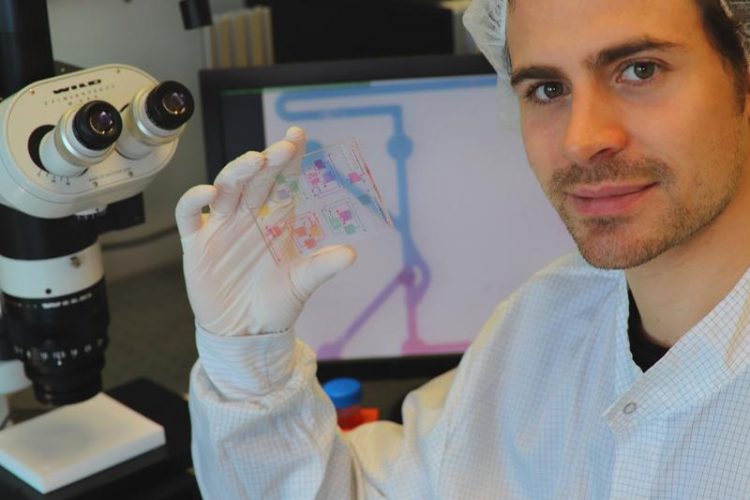Chemical Circuits for the Molecular Diagnosis and Treatment of Previously Incurable Diseases

Anthony Beck, co-developer of the technology, holds a chemical circuit with coloured analysis media. In the background is a microscopic image of one of the chemical transistors of the chemical IC. TU Dresden
However, this will require molecular analysis systems that can examine hundreds or thousands of these cells individually and simultaneously. Current technology does not allow such analyses.
Scientists in Dresden would therefore like to use chemo-fluidic circuits developed at the “Center for Advancing Electronics Dresden” cluster.
These are based on chemical transistors, which, analogous to microelectronics, make it possible to combine complete information-processing systems on a single chip.
However, they do not control electrical currents, but rather the fluid currents containing the human cells, which are to be examined. And they themselves are directed through the chemicals and liquids necessary for the analysis.
The researchers strive to build integrated circuits that, owing to the combination of thousands chemical transistors on a chip, are able to independently and simultaneously conduct complex analysis procedures on hundreds or thousands of individual human cells.
Initially, the scientists will focus on the development of chemical chips for the diagnosis of a special type of white blood cell cancer (acute myeloid leukaemia), for which therapy could be fundamentally improved if successful. At a later stage, they hope to develop circuits for the treatment of other diseases.
Financing by the VIP+ Programme of the BMBF:
With the High-Tech-Strategy 2025 “Research and Innovation for People”, the Federal Government has set itself the goal of identifying the diverse application potentials of excellent research even more quickly and effectively, and of making them available to industry and society.
To achieve this, the bridge between academic research and it’s commercial exploitation or societal application must be further strengthened. The BMBF funding measure “Validation of the technological and societal innovation potential of scientific research – VIP+” addresses this issue and supports researchers in systematically validating research results and in opening up areas of application.
Prof. Dr. Andreas Richter
Technische Universität Dresden
Faculty of Electrical and Computer Engineering
Institute for Semiconductors and Microsystems
01062 Dresden
Email: andreas.richter7@tu-dresden.de
Tel.: +49 351 463 36336
Prof. Dr. Mario Menschikowski
Carl Gustav Carus University Hospital Dresden
Institute for Clinical Chemistry and Laboratory Medicine
Fetscherstr. 74
01307 Dresden
Tel.: +49 351 458-2634
Email: Mario.Menschikowski@uniklinikum-dresden.de
Media Contact
More Information:
http://www.tu-dresden.deAll latest news from the category: Life Sciences and Chemistry
Articles and reports from the Life Sciences and chemistry area deal with applied and basic research into modern biology, chemistry and human medicine.
Valuable information can be found on a range of life sciences fields including bacteriology, biochemistry, bionics, bioinformatics, biophysics, biotechnology, genetics, geobotany, human biology, marine biology, microbiology, molecular biology, cellular biology, zoology, bioinorganic chemistry, microchemistry and environmental chemistry.
Newest articles

A universal framework for spatial biology
SpatialData is a freely accessible tool to unify and integrate data from different omics technologies accounting for spatial information, which can provide holistic insights into health and disease. Biological processes…

How complex biological processes arise
A $20 million grant from the U.S. National Science Foundation (NSF) will support the establishment and operation of the National Synthesis Center for Emergence in the Molecular and Cellular Sciences (NCEMS) at…

Airborne single-photon lidar system achieves high-resolution 3D imaging
Compact, low-power system opens doors for photon-efficient drone and satellite-based environmental monitoring and mapping. Researchers have developed a compact and lightweight single-photon airborne lidar system that can acquire high-resolution 3D…





















